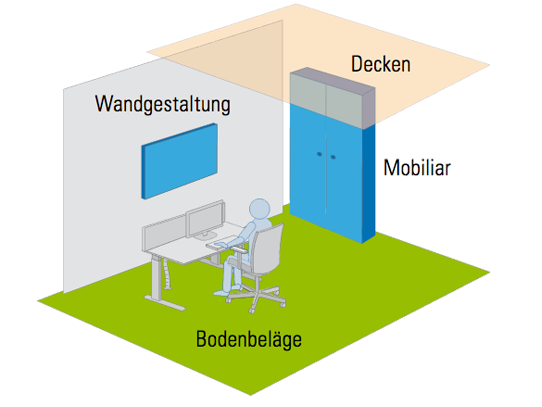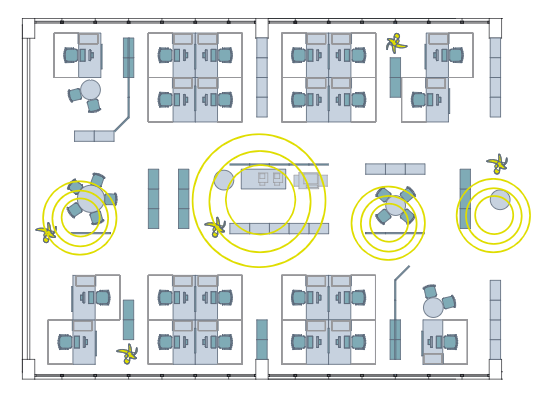
Noise causes stress
Even relatively low noise levels cause stress and decrease employees’ performance capacity, according to psychologists working at Cornell University in Ithaca. In his studies, Gary Evans, a professor of environmental psychology, came to the conclusion that employees working in noisy offices are 40% less likely to try to solve technical or functional problems. In comparison to people working in quieter rooms, they also make only half as many ergonomic adjustments to their furniture or their computers.

of employees are regularly distracted by noise.
Source: IBA/bso study 2015

CONVERSATIONS ARE THE NUMBER ONE SOURCE OF DISTURBANCE
The most frequent causes of distraction are colleagues’ conversations and ringing telephones. The problem: Both kinds of noise provide stimulation and information. They are impossible to ignore. The human ear is always in the “receive” mode. The only solutions are room acoustics measures, modern telephony technology, and good spatial planning.

MOST IMPORTANT STARTING POINT: ROOM ACOUSTICS
The term room acoustics refers to the acoustic conditions within a room. In contrast, building acoustics deals with the transmission of sound between different rooms or from outside areas into a room. Consequently, room acoustics measures are needed to eliminate the biggest sources of disturbance in the office (see above).
Measures



ROOM ACOUSTICS MEASURES
In most cases, a combination of sound-absorbing and sound-shielding measures can solve the problem. Sound-absorption reduces noise, sound-shielding interrupts its direct transmission - at least partially.
Because of their large surface area, ceilings (acoustic ceilings, baffles) and walls (wall panels, acoustically effective pictures) are ideal sites for sound-absorbing measures. Transparent acoustic foils can be installed in front of large glass surfaces. Wall-to-wall carpeting effectively absorbs high-frequency sounds. Also, many pieces of furniture have a good sound-absorbing effect.
Storage cabinets, partition walls or table attachments can be used for sound-shielding. They are especially effective if they are provided with sound-absorbing surfaces and are placed as close as possible to the sound source - e.g. a workstation where a lot of telephone calls are made or a meeting island.
For more information, see Room acoustics.

You can see and hear the effects of various measures in a short explanatory film on room acoustics in the media library of the IBA Forum.
This video is currently only available in German. We are working on a translation.
AREA PLANNING
Optimization already begins with area planning. An analysis of employees’ tasks and communication patterns will reveal which individuals need demarcated workplaces. The reasons for this need might be tasks that require a lot of concentration or a high degree of confidentiality. Legal conditions, such as those related to works council offices, may also require separate workrooms.
For all other employees, ideally
- the workplaces should be arranged in such a way that people who communicate often with each other are placed as closely together as possible;
- meeting rooms and communication areas are located away from workplaces a much as possible;
- groups of workplaces and meeting rooms are effectively soundproofed;
- workplaces are not too close together.
COMMUNICATION TECHNOLOGY
Disturbances caused by telephone calls can be reduced through the use of technology. The use of headsets makes it possible to communicate understandably even at low volumes. Distractions due to ringing telephones can also be avoided. Optical signals are an alternative to telephone ringing.
In any case, longer video calls should be moved to separate rooms.

